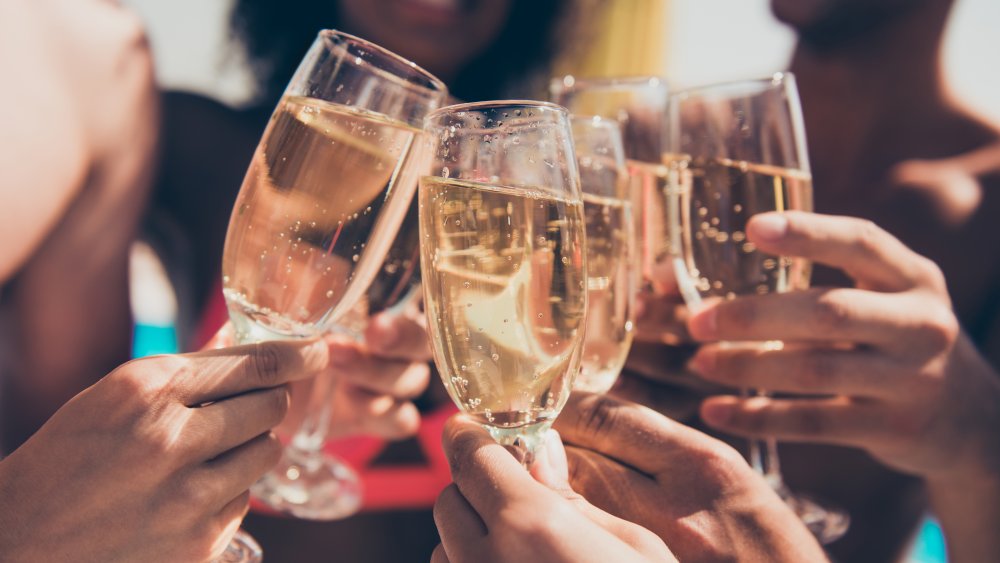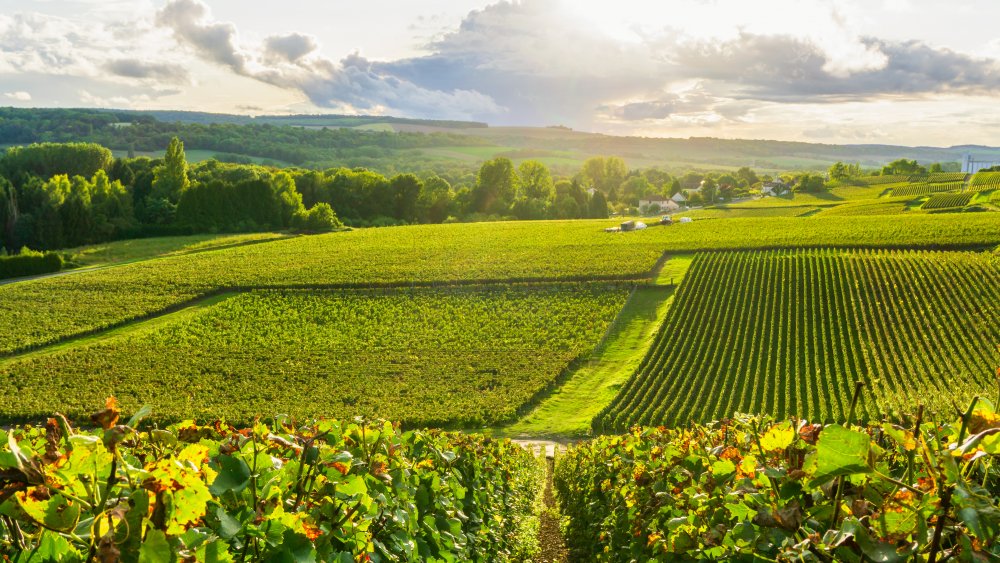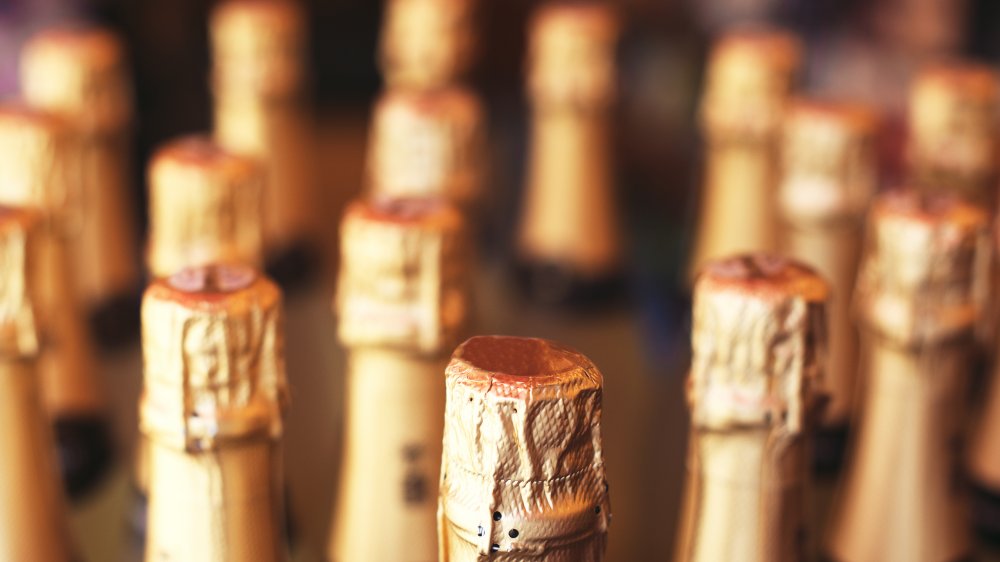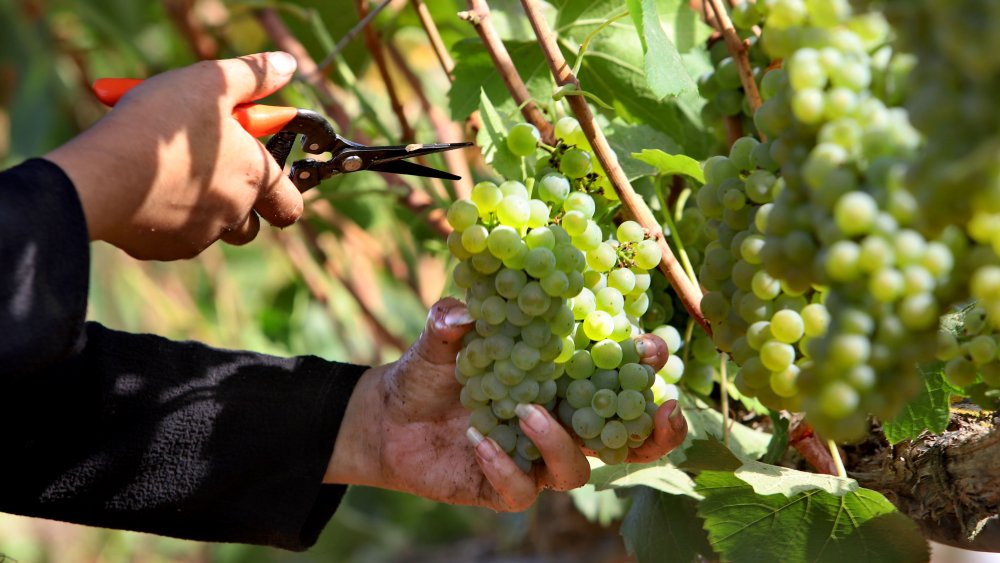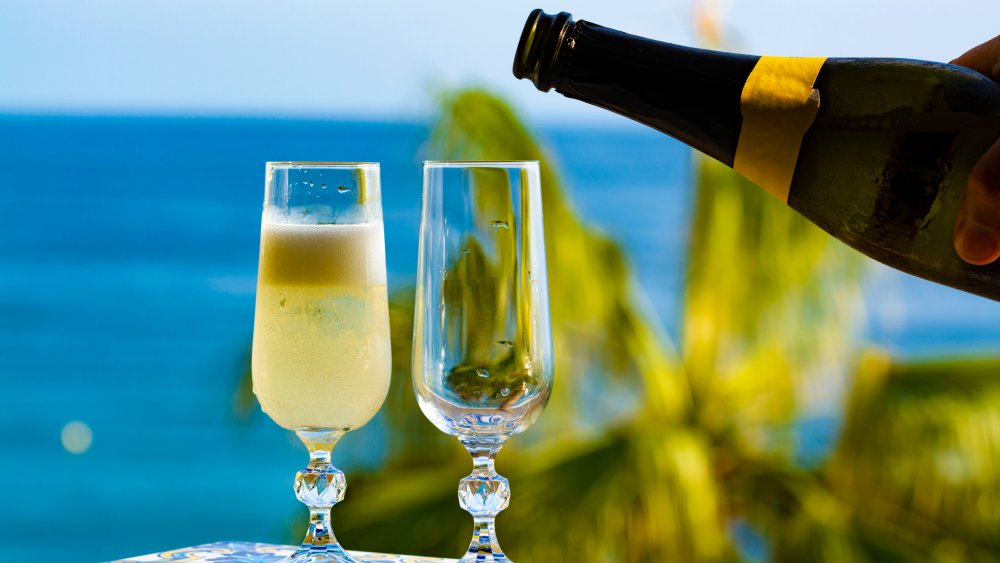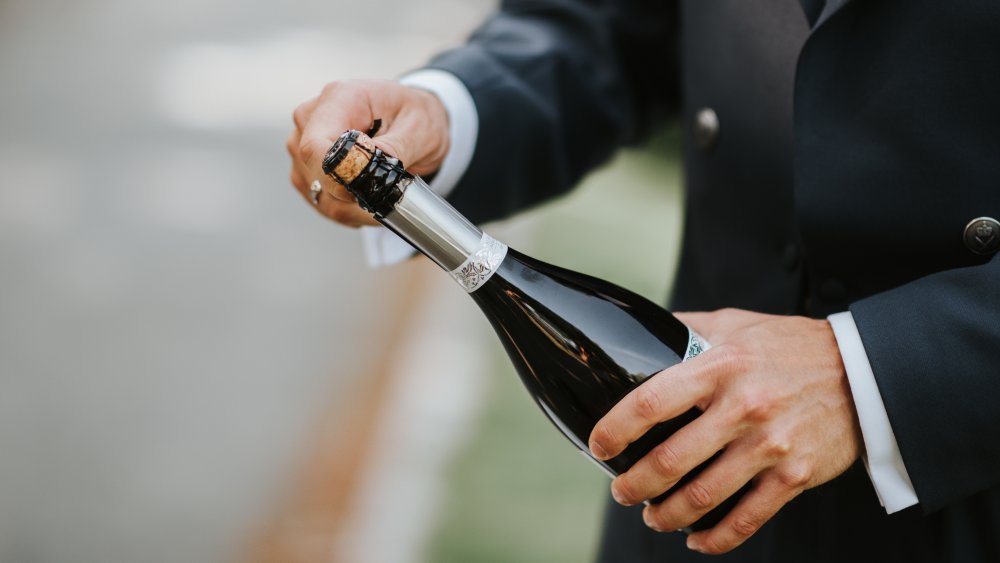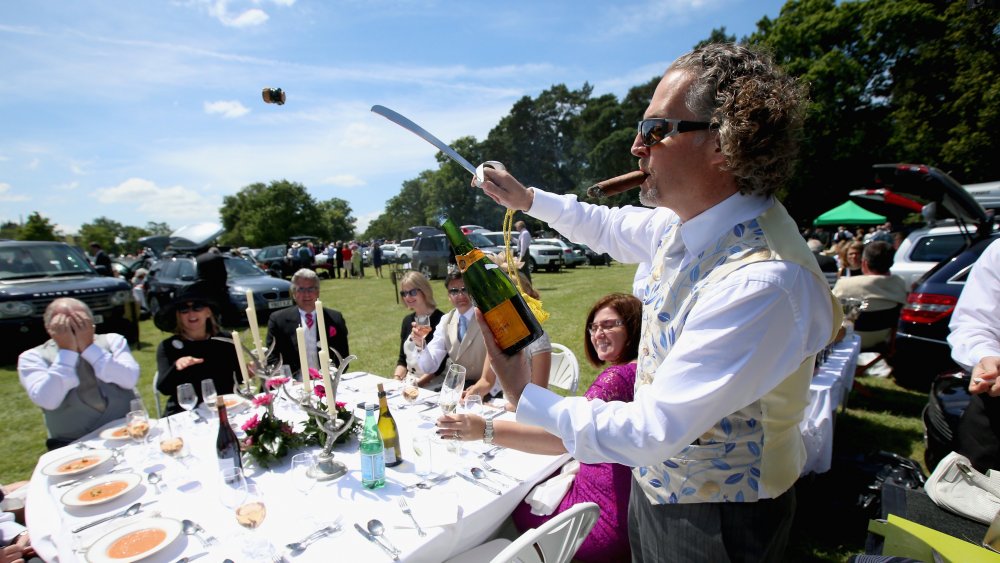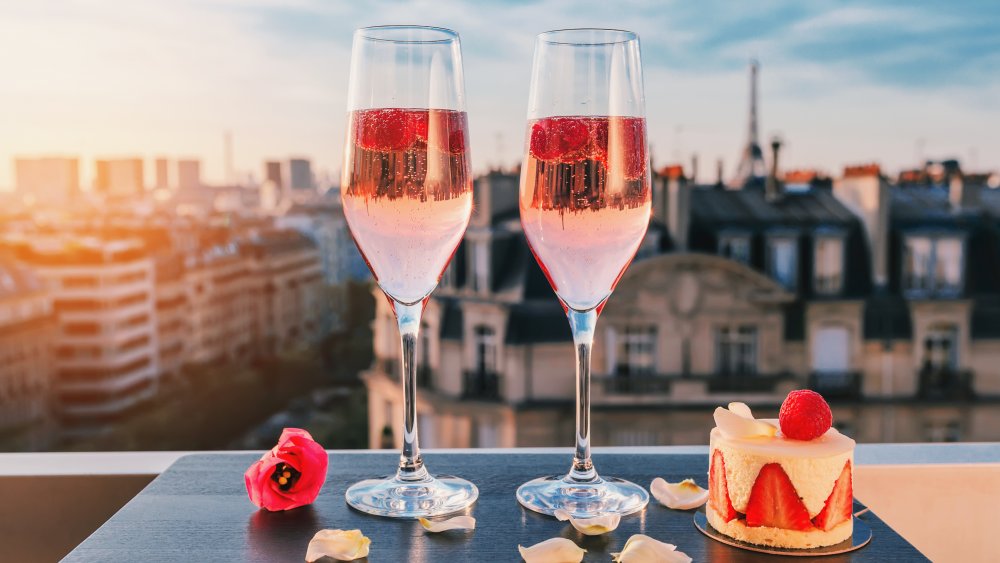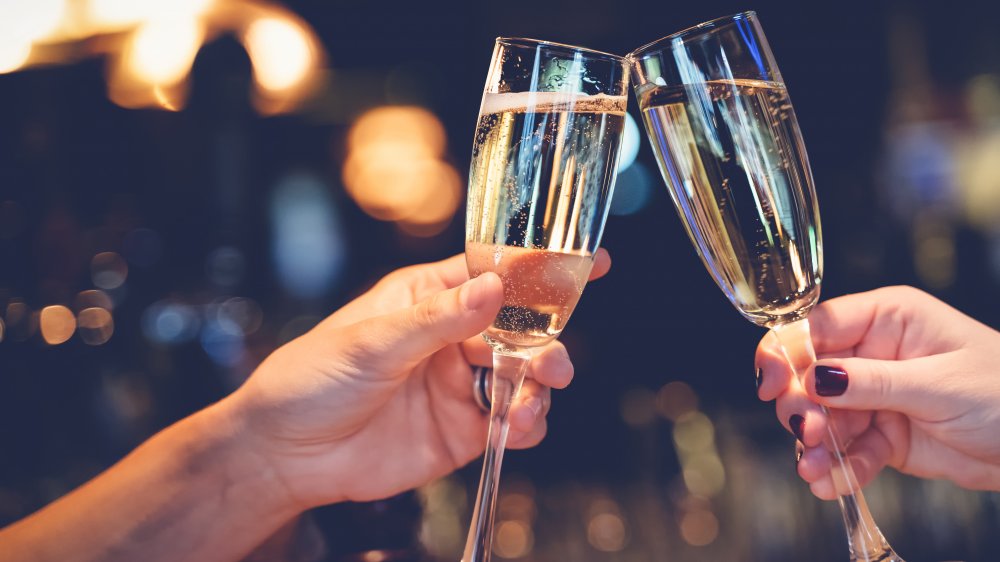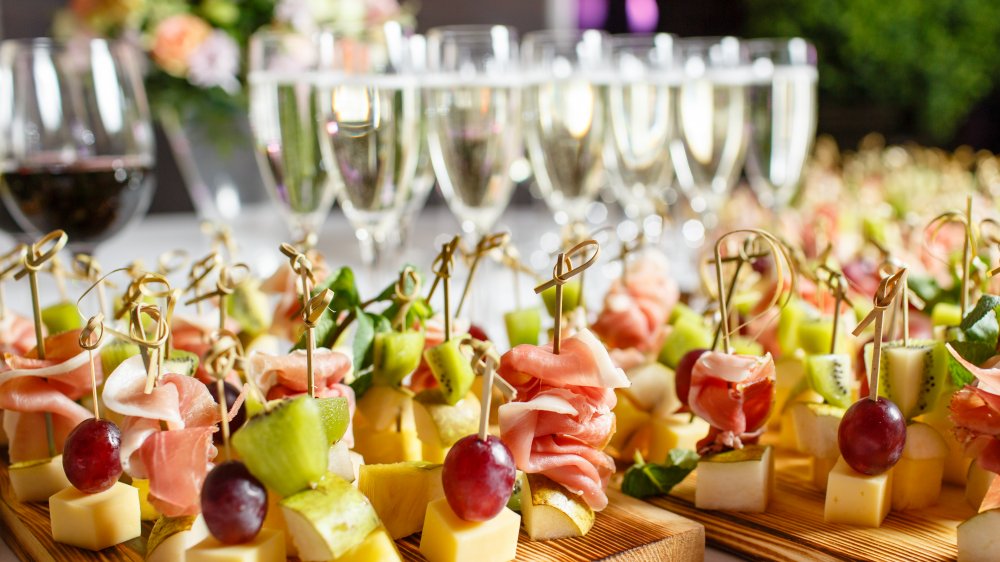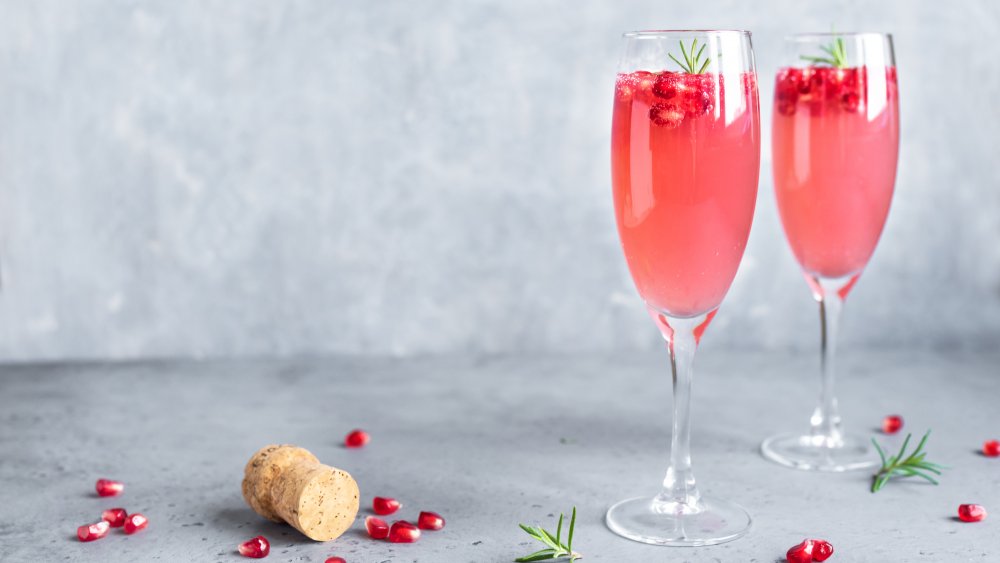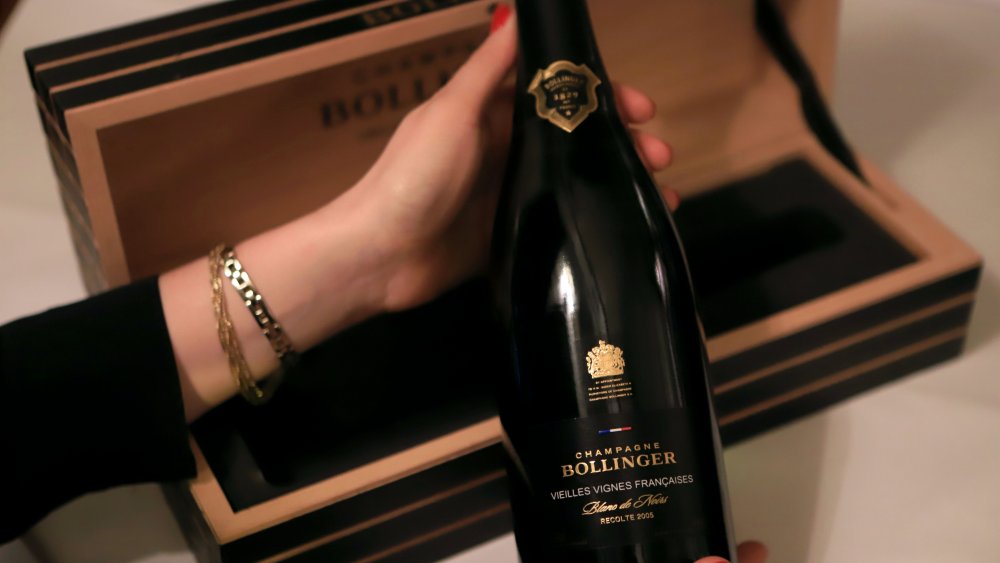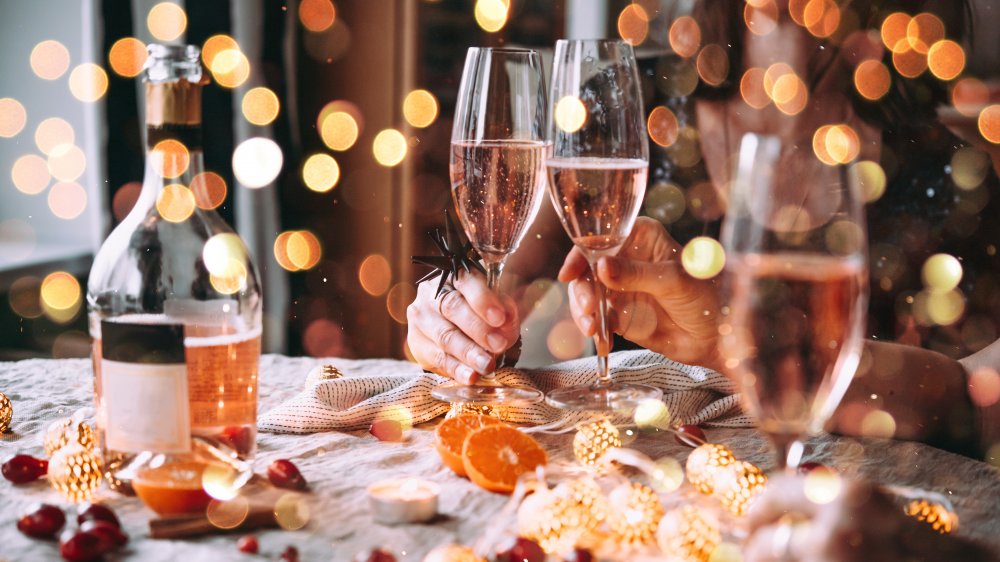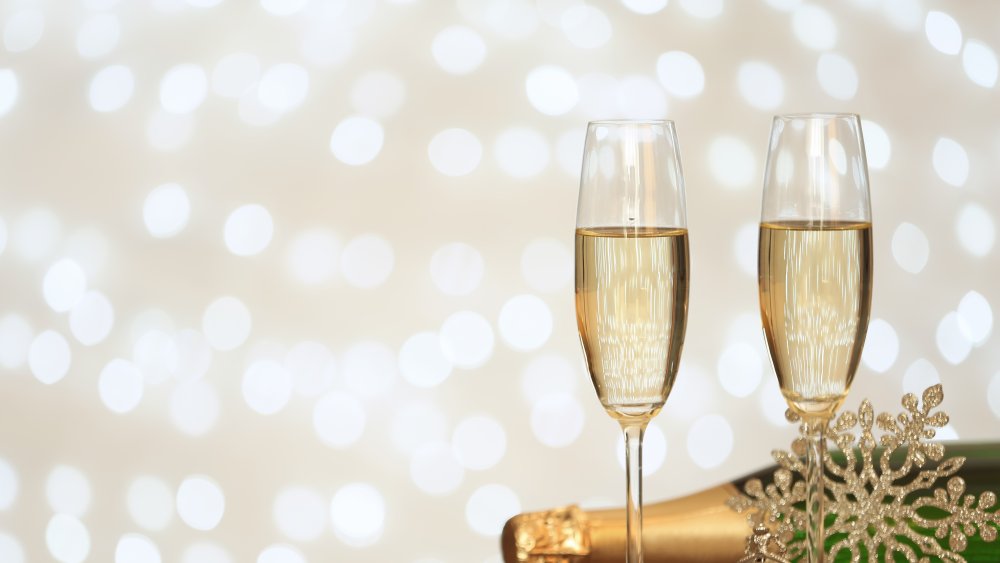What You Should Know Before Taking Another Sip Of Champagne
Pop! Fizz! Click! Champagne is easily one of the most celebratory drinks on the market. Whether celebrating a holiday, a job promotion, or an anniversary, chances are that those reveling in the moment are poppin' bottles to raise a toast.
Americans take the title for the largest foreign market of champagne consumers. And considering there are an estimated 49 million bubbles in each bottle, that's a whole lot of bubbly being consumed. Of course, 25 percent of the champagne sold in the U.S. is purchased in the week leading up to New Year's Eve, but that still leaves plenty of fizzy bubbles for celebrating all year long. Mimosas for brunch, anyone?
But champagne certainly isn't just as simple as a wine with bubbles. From where it's from to how it's made, champagne is one of the most regimented alcoholic beverages on the market. Luckily, we decided to take a deep dive to find out more. This is everything you need to know before taking another sip of champagne.
Real champagne is made in France
One of the most important things to recognize about champagne is that not all bottles of bubbly can be considered champagne. Certainly, all champagne can be considered a sparkling wine, but not all sparkling wine can be called champagne. And that has everything to do with the location of where it's produced.
In order to truly be recognized as champagne, a bottle of bubbly must be made in the Champagne region of France. As of 1891, France's Treaty of Madrid established the Northeastern region's legal right to call their wines champagne.
There is one loophole to this naming convention, though. Some California winemakers are able to label their sparkling wines as California Champagne, but only if they had been calling their product that before 2006. In order to promote wine trade, the United States and European Union came to an agreement that American wineries would stop using generic naming conventions such as California Champagne or Chablis unless that producer had already been using it.
Champagne is made a very specific way
Champagne is made in a similar way to white and red wine options. It just might be handled with a bit more care.
Champagne is often made from grapes with black skins, which is what gives red wine its color. So, it's important that the production process is very meticulous. Grapes are carefully pressed to get the juice out, without the addition of the skins, before the juice is put in stainless steel to ferment. Next, the juice is often blended with other wines to create balance before it's bottled.
Once bottled, yeast and sugar are added before the bottle is sealed to begin the second fermentation. In the bottle, the yeast begins to consume sugars, creating a higher alcohol content and producing the carbon dioxide that ultimately makes the bubbles that champagne is known for. As the second fermentation takes place, the bottle is turned so that the yeast particles make their way down to the neck. The dead yeast cells are removed by dipping the bottle in a frozen solution, which freezes the yeast particles together and ultimately forces them out quickly while the bottle is opened. To make up for the champagne that's lost, a bit of wine and sugar is added to the top, and the bottle is resealed with a cork. A wire cage and foil wrapping are added for extra protection, keeping the cork from popping open before the champagne is enjoyed.
There are three main grape varietals used for champagne
Choosing a bottle of champagne can be a little bit different than making a selection for a bottle of red or white wine. Whereas there are countless options for grape varietals for reds and whites, from Pinot Noir to Viognier and Sauvignon Blanc to Zinfandel, there are three main types of grape varieties used for making champagne.
The Champagne wine region of France produces more Pinot Noir, Meunier, and Chardonnay grapes than any other varietal. But what's surprising about champagne is that the two main types used most frequently, Pinot Noir and Meunier, are not white grapes. The common misconception that champagne must be made with white grapes all the time is certainly untrue, as other varietals are utilized because of their unique flavors and aromas. But what it boils down to is the method of production, opting to avoid getting any coloring from the skins of those darker grapes into the wine.
You can still drink bubbles without splurging for champagne
Because of the monopoly France has on the word Champagne, requiring that the beverage be produced in that region, it can be a little pricey. The exclusivity of champagne is certainly what draws many people to enjoy it, but with that name comes a higher price tag. But what about the bubbly being produced in other regions of France or even outside of France? They're still a perfectly acceptable (and often more budget-friendly) option.
Crémant is produced in France, but it's not made in the same region to allow it to be called champagne. It's still made with that secondary fermentation, making it very similar to a classic champagne option. Well-known crémant regions include Burgundy, Alsace, and the Loire, producing crémant options that utilize grape varietals such as Pinot Gris, Pinot Noir, Chardonnay, and Chenin Blanc, depending on the region.
Sparkling wine is another great choice, which is heavily produced in California, with other wineries throughout the U.S. producing a sparkling wine option as well. Sparkling wine is typically produced using the same method as champagne, but it's not uncommon to see other varietals being incorporated into the process.
There's a certain way to open a bottle of champagne
If you're ready to pop open that bottle of bubbly you've been saving for a special occasion, the last thing you want is for it to result in injury. But with a little prep, you'll be just fine.
The American Academy of Ophthalmology reported that champagne bottles can be the culprit of serious eye injuries, especially around New Year's celebrations. And that's all due to the incredibly high pressure in the bottle. Because of the carbon dioxide in the bottle, poppin' the top off a bottle of champagne can cause the cork to fly across a room at 50 miles per hour.
To avoid any injury, it's important to avoid pointing the bottle toward anyone. Remove the chilled bottle from the fridge and remove the foil. The champagne should be at a chilly 45 degrees. As you unwind the wire cage around the cork, it's important to apply pressure with your palm and continue to twist the bottom of the bottle. Once you feel the pop of the cork, gently ease the cork out of the bottle to avoid it flying across the room.
Yes, you can open a bottle of champagne by sabering it with a sword
If you're a bit more of an advanced champagne drinker, and you've got the basics down pat of how to open the bottle, there's definitely a way to step it up a notch. This might just be the most impressive party trick when it comes to champagne.
Because of the high pressure in the bottle from all of the carbon dioxide forming those little bubbles, it's possible to slice the top off of the bottle with a sword. Chilled bottles of champagne are used, with the foil and wire cage on the cork removed. Using a sabering sword, which is intentionally designed without a sharp edge, the champagne can be opened by finding the seam that runs toward the top of the neck of the bottle. To saber the bottle, sliding the sword along the seam of the bottle in a firm, swift movement will slice off the top of the neck.
This is definitely a move to only make if you've been taught how to saber the bottle, and ideally if you're still sober. Plenty of things can go awry if you're not trained in the art of sabering correctly.
Some glasses are better for champagne than others
If you order a bottle of bubbly at the restaurant, chances are your bottle will arrive with two champagne flutes. The same typically goes for a catered wedding or company holiday party, as the catering company has this type of specific glassware on hand. And there's certainly a reason for that. Champagne flutes can help to keep your bubbles chilled because of the long stem of the design. But there may be a better option for truly enjoying a glass of bubbly.
Champagne can definitely be enjoyed from any type of glassware. If a coffee mug is all that's available, of course, it's still drinkable. Any type of glassware from white wine glasses to coupes are acceptable, but a tulip glass may actually be the better bet.
A tulip-shaped glass will allow the notes of the champagne's flavor to shine through much more than it can in a flute, according to the Wine and Spirit Education Trust. Because of the tapered design, the aromas are also better enjoyed with every sip, creating a better overall experience for those hoping to savor their glass of champagne.
Champagnes have varying levels of sweetness
If you've ever seen the terms "Brut" or "Demi-Sec" on a bottle of champagne, it isn't just to make the bottle seem extra fancy. There's actually a meaning behind those labeling terms.
Champagnes are measured for their sweetness, and those labeling conventions will tell you whether the champagne you're about to enjoy will be super sweet or whether it will have little to no sweetness at all. When a champagne maker adds additional sugar (often from grape must) before corking a bottle, it changes the taste of the champagne, ultimately creating balance to an otherwise acidic product. This creates balance in the wine, but just like each winemaker does their Cabernet Sauvignon differently than the next winemaker, the same goes for champagne. Producers have the liberty to decide how sweet of a champagne they want to make and sell.
The range runs from Brut Nature, Extra Brut, Brut, Extra Dry, Dry, Demi-Sec, and Doux. Brut Nature or Brut Zero champagnes have very little residual sugar, making it the least sweet of the options, working up to Doux with the highest sugar content. And while each of these varying sweetness level options are definitely available on the market, the majority of champagnes are produced at some variation of a Brut level of sweetness.
Champagne pairs perfectly with certain foods
Certainly, there are plenty of classic wine and food pairings out there. Each is touted for the way nuanced flavors come together perfectly. But typically, those pairings are all focused on wines such as a big, bold Cabernet Sauvignon paired with a juicy steak or an oaky Chardonnay paired with scallops. But champagne certainly has its own perfect food pairings to consider.
Because the bubbles in champagne can help to cut through bold flavors and textures, it makes for the ideal complement to creamy cheeses such as brie or mascarpone. But it's also well paired with a dessert that features buttery or honey elements, along with fruits and custards.
Champagne can also be the perfect pairing for many comfort foods. Because of the way the acidity in the champagne cuts through certain foods, dishes like macaroni and cheese, fried chicken, ravioli, or grilled cheese can be ideal complements.
You can use champagne to make a delicious cocktail
While it's easy to sip glass after glass of champagne on its own, or accidentally consume a whole bottle in one sitting, there are plenty of other ways to enjoy this bubbly beverage.
One of the most quintessential champagne cocktails, the French 75, first appeared in print in 1927. The combination of lemon juice, sugar, London dry gin, and champagne made for a perfectly balanced and refreshing cocktail, and it's a drink that's still popular in bars today.
Of course, a simple mimosa is the ideal brunch sipper, combining orange juice and champagne, but a delicious cocktail can also be made by pairing champagne with Grand Marnier to create a Grand Royal. Or, champagne can be utilized to create a delicious and festive punch by adding two bottles of champagne to a punch bowl, paired with vodka, Grand Marnier, cranberry juice, and cranberries.
Many bottles of champagne don't have a vintage
The vintage, or year, listed on a bottle of wine can tell you a lot about it. First and foremost, a vintage explains the year in which the grapes were grown and harvested for that particular bottle. Even if the bottle is released for sale years later after being aged, it will still feature the vintage year to reflect the actual growing season for those grapes. And for many wine aficionados, that number can tell you more about the nuances of the wine, because of the weather that the grape's particular growing region experienced that year.
But with champagne, it's a bit different. Because many champagnes are produced by blending a variety of vintages, one single year cannot be listed on the bottle, per Decanter. Often, a champagne producer may need to use juice from multiple years, because of the difficult growing conditions the Champagne region sees. And in order to stay consistent, being able to continue to produce and sell champagne, a producer will often opt to create a house formula that's repeated year after year.
There are some champagne bottles that might feature a vintage, meaning they were produced during a prime growing season, but it's quite uncommon. And because this is fairly rare to see, these bottles are often considered the crème de la crème.
Champagne can cause some of the most terrible hangovers
Certainly, drinking any type of alcohol in excess has the potential to cause a terrible hangover. But when it comes to champagne, that raging headache, nauseous stomach, and achy body might just be that much worse. And that all has to do with how champagne is made.
Carbon dioxide is created in the bottle as the yeast converts sugars into alcohol, which is what makes the millions of bubbles you're sipping when you enjoy champagne. And while carbon dioxide is to thank for that fun, fizzy feeling when you sip, it also causes your bloodstream to absorb the alcohol found in champagne that much quicker. Ultimately, that raises your blood alcohol levels, getting you drunk on champagne that much faster. And often, it's difficult to tell just how intoxicated you are off champagne, so it's common to just keep sipping after that first glass or two. At the same time, champagne typically has more sugar in the bottle as well, contributing to those dehydrating effects so commonly known with a hangover.
Champagne might actually be good for you
It's not every day that you hear an alcoholic beverage might actually offer up some health benefits along with it, but hear us out. Since champagne is made from similar grape varietals to your typically red and white wine options, some of the health benefits that come with enjoying a glass of red at the end of the day follow through to champagne, according to the Evening Standard.
Champagne has the potential to improve heart health because of the antioxidants found in the wine, ultimately reducing bad cholesterol levels and preventing blood vessel damage. Champagne also has the potential to help improve short term memory, as well as act as an instant mood booster thanks to the potassium, zinc, and magnesium found in the bottle.
Of course, these benefits come from responsibly drinking champagne in moderation. Sure, you get the same benefit by consuming copious amounts, but be sure to remember the terrible hangovers that come as a side effect of drinking too much champagne.
